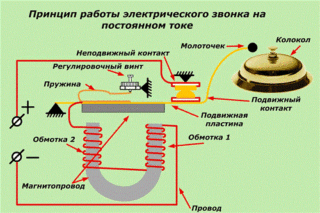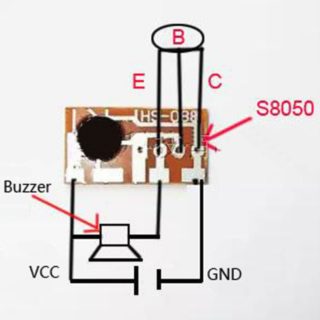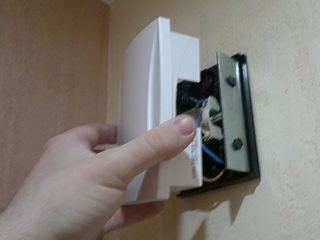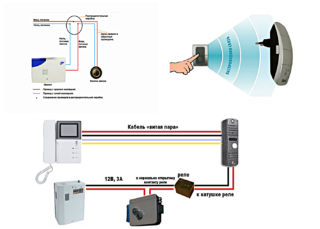The electric bell is widely used by unauthorized persons when it is necessary to get into houses and other objects. With their help, it is possible to transmit an audio signal over long distances. To form a call in modern devices, an electronic circuit is used, built either on semiconductor elements (transistors) or on modern microcircuits.
Device and principle of operation

The door bell is very simple and consists of a limited number of parts. Its design contains the following mandatory assemblies and components:
- the call button, taken out to the front door, usually it is attached to the side of the jamb;
- a ringing signal generation unit located inside the serviced object: the entrance of an apartment building or apartment;
- a set of wires used to connect these nodes and make them work together.
In modern models of electronic calls, called wireless, instead of line cables, a radio channel is used, that is, the ringing signal is transmitted over the air.

In electronic models, after applying the voltage and lowering it to an acceptable level, an electronic signal is generated in the circuit, which goes to the acoustic transducer (speaker). For wireless calling devices, the same process is repeated exactly, except that the control signal is transmitted over the air.
Types of calls
According to the principle of forming a ringing signal, a wired call can have the following versions:
- electromechanical ringing devices;
- electronic calls.
Electronic devices can have a volume control located on the front panel that allows you to change the level of the signal going to the built-in speaker.

Differences in the operation of electronic and electromechanical samples are manifested in various mechanisms for converting and supplying a ringing signal. In addition, according to the method of transmitting information messages, electronic calls are divided into wired devices and their wireless counterparts (radio-controlled models). By the type of signal that provides the user with information about the call, they can be audible or visual (the latter category refers to video recorders). According to their location, all existing models of electric ringing devices are divided into street and intra-apartment calls.
Analysis of the varieties of bell mechanisms and selection criteria

Electromechanical door bells with a striking mechanism are outdated long ago and are found today only among pensioners and in rural areas. They were replaced by electronic counterparts, in which there is not a single mechanical unit.A wired electronic call to an apartment is made in the form of a circuit board with transistor-based generator circuit elements that can reproduce sound through a speaker.
Sometimes the ringing signal generator is assembled on the basis of a specialized "music" chip that generates several melodies. These calls are more preferable than the outdated electromechanical model, but in turn are inferior in terms of ease of use to radio-controlled counterparts. The installation of such a product will take much less time, since in this situation there is no need to lay electrical wires. However, all these benefits come at the expense of the high cost of wireless devices.
What is important to consider when choosing

It is possible to choose a good and reliable electric wire call to an apartment only after all the pros and cons of the options considered have been weighed. If you need an inexpensive and easy-to-use device, it is best to choose a conventional electric bell with an electronic circuit that generates several melodies. In a situation where there is no desire to fiddle with the wiring or it is impossible to lay it and at the same time the question of costs does not bother the user, a radio-controlled device is considered the most suitable option.
When choosing a wireless or wired electric doorbell for an apartment, it is also important to consider the installation location of the call button: on the street or in the entrance. In the first case, it must have a high degree of protection against destructive factors, determined by the technical IP indicator (the higher, the better). It characterizes the level of its tightness, preventing the penetration of dust and moisture.
Indoor products may include a ringer that has a conventional design with IP 20-44, for example.
Installation features

The order of installation of the elements of the calling device depends on its modification and configuration, which are considered for each option separately. In any case, before starting work, you will need to prepare the following tool:
- indicator screwdriver;
- ordinary screwdriver;
- side cutters - necessary for cutting off the conductor of the required length.
From the materials, you need to prepare miniature adapter pads with slots for a screwdriver and two pieces of wiring of the required length.
Installing a wired device

Wired doorbells are installed at their place of work in the following sequence:
- It is necessary to de-energize the apartment by turning off the introductory machine.
- A box with an electronic circuit is taken, from which two white conductors are brought out, and hung on the screws screwed into the wall.
- It is necessary to connect one end of the wire by means of a miniature adapter block to the brown conductor connected from the phase terminal of the input board or distribution box.
- The second end, using the same block, is connected to a long piece of wire laid along the wall to the call button, and connected to one of its terminals.
- After that, from the second push-button contact, the same conductor is laid next to the first one to the zero terminal of the junction box or panel.
At the final stage of work, it will remain to turn on the introductory machine and check the call for operability
When checking the signal chain, you need to act carefully, constantly remembering that when the button is not pressed, one of its terminals is energized at 220 volts. You can check its absence or presence using the indicator screwdriver prepared earlier.
Wireless device

In the case of a wireless device, the installation operations are as follows:
- At the selected place in the apartment, a box with a receiver is attached to the wall, powered by a previously installed battery.
- On the jamb of the entrance door, a signal transmitter designed in the form of a panel with a button is fixed, which also needs a built-in battery.
- To test the call device, press the bell button and listen to the sound signal.
- If there is a volume control, you need to make sure that it works properly.
If the receiving device is powered from the mains, its terminals should be connected according to the color marking: the red or brown core - to the phase contact in the junction box, and the blue one - to the zero terminal.
If the receiver for some reason does not work, you need to rearrange the batteries again in case there is poor contact at the place of their connection.
There is no need to turn off the electricity when connecting the battery-operated wireless chime, since it is not in use.
Connection diagrams and useful tips

In one of the options for connecting the doorbell, the use of two buttons located at some distance from one another is provided. This is usually done in private houses, where the entrance to the dwelling is located in different places for a number of reasons. A wired apartment bell with two buttons is mounted according to a more complex scheme. So that when each of them is pressed, the same actuator is triggered, the calling circuits are connected in parallel.
There are ring patterns in which a backlight lamp is provided on the panel of the actuator, which duplicates the call for people with hearing impairments. To reduce the risk of electric shock, a transformer is built into modern electronic models, to which 220 volts are supplied. From its output, a safe voltage (12-36 Volts) enters the power line of the call button.
When installing the call device, it is recommended to adhere to the following rules:
- conductors are mounted as secretly as possible, which excludes the possibility of accidental damage to the insulation and injury to a person with a voltage of 220 volts;
- the bell body with call adjustment is mounted on the wall at eye level;
- when choosing a location for it, the characteristics of a particular object are taken into account, including the presence of a nearby switchboard.
When choosing a wireless call, it is important to remember to constantly monitor the condition of the batteries, which over time are discharged.








